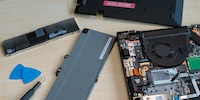
Background information
"Framework is my goal": the dream of the modular ThinkPad
by Jan Johannsen

Intel wants to make notebooks and PCs more modular. To this end, the chip manufacturer is proposing a new standard for motherboards, which should ultimately benefit PC manufacturers, customers and nature.
Intel wants to make notebooks and PCs more modular. To this end, the chip manufacturer is proposing a new standard for motherboards, which should ultimately benefit PC manufacturers, customers and nature.
With the Framework Laptop, modularity in notebooks has become a reality. Other manufacturers such as Lenovo are moving in a similar direction with easy-to-change batteries, keyboards and memory. Intel now wants to give the topic even more impetus by changing the structure of motherboards. Something that no manufacturer can do alone.
In a blog post, Intel proposes a new standard for motherboards to the PC industry. Initially, this involves those for notebooks and mini PCs. The motherboard is to lose tasks to two so-called I/O boards. These should be able to be used across different platforms and market segments. Manufacturers would benefit from cost savings as the duration of the design cycle is extended and technical investments are minimised.
Intel's proposal is modelled on the automotive industry, where some components are already used for various models. For example, a base frame with different chassis and engines is used for different models.

Intel's I/O boards for premium PCs are designed to fit into notebooks with two, one or no fans, for example. Users should be able to expand their memory with standardised modules such as M.2 SSDs and core boards or easily upgrade to a next-generation system-on-a-chip (SoC). In the event of damage, the entire motherboard does not have to be replaced, making repairs easier and cheaper.
Intel is planning slightly different I/O boards for entry-level and mainstream notebooks with one or two fans. However, these should also fit into different display sizes and allow the core, memory and Wi-Fi to be easily replaced. For desktop PCs with a volume of five litres, Intel is talking about replacing the GPU and hot-swappable - i.e. hot-swappable - memory.

Intel divides the modularity of PCs into three areas: Factory, field and user. The proposed I/O boards fall into the area of factory modularity. This is where the manufacturers come in. On-site modularity refers to customisations that a dealer or workshop can make for the customer on site. However, Intel only has one example of this from the automotive sector: fitting a new set of tyres. By user modularity, Intel means interventions that can be carried out at home at any time.

Intel is pursuing six goals with its modular PC design:
In addition to benefits for manufacturers and users, Intel has identified e-waste as a major problem. 70 per cent of it comes from computers. With the modular I/O boards, the chip manufacturer wants to reduce the amount of electronic waste generated and increase the current miserable recycling rate of twelve per cent. According to estimates, materials and minerals worth over 65 billion US dollars are currently lying in landfill sites worldwide.
In order for the I/O boards to become a reality, PC manufacturers must accept Intel's proposal or at least discuss it and improve it if necessary. There is no timetable. It is currently impossible to say exactly how long it will take for the new I/O boards to be integrated into notebooks that can be purchased.
As a primary school pupil, I used to sit in a friend's living room with many of my classmates to play the Super NES. Now I get my hands on the latest technology and test it for you. In recent years at Curved, Computer Bild and Netzwelt, now at Digitec and Galaxus.